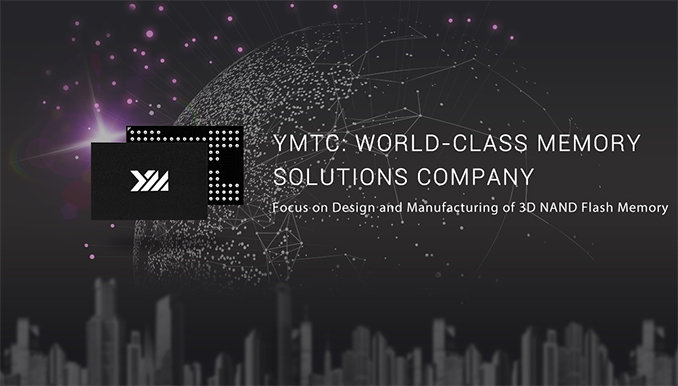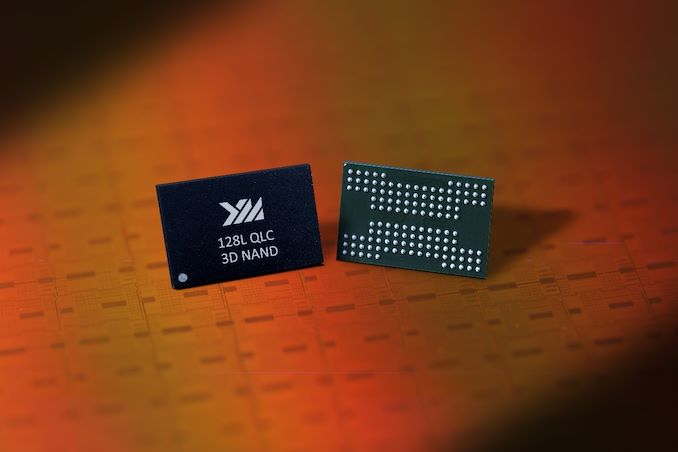China Develops High Capacity QLC 3D NAND: YMTC at 1.33 Tb
by Gavin Bonshor on April 13, 2020 11:00 AM EST
Yangtze Memory Technologies Co. (YMTC) has announced that it's developed its new 128-layer 1.33 Tb QLC 3D NAND memory chip, the X2-6070. The new chip is based on its Xtacking architecture which enables it to run with super high I/O while maximising the density of its memory arrays. YMTC has also unveiled its plan for a 128-layer 512 Gb TLC chip, the X2-9060, designed to meet more diverse application requirements.
We first reported on the China-based company YMTC entering its 3D NAND memory chips into production back in 2018, when it unveiled its Xtacking Architecture at the Flash Memory Summit. While it didn't disclose technical details of its announcement, it did state the Xtacking architecture has the capability to run the I/O with speeds of up to 3 Gbps. Fast forward to 2019, and it announced that it planned to start volume production of its 64-layer 3D NAND which we also reported on.
Using its Xtacking architecture at the forefront of production, both the new X2-6070 and X2-9060 feature its updated 2.0 variant which YMTC claims to bring more benefits to flash memory. Both the X2-6070 and X2-9060 are claimed to deliver up to 1.6 Gb/s of I/O performance and operate with a Vccg voltage of 1.2 V. YTMC has stated that the X2-6070 QLC based chip will be first used in consumer-grade SSDs, with the aim to then deliver its capabilities into Enterprise focused drives.

YMTC X2-6070 128-Layer QLC 3D NAND memory chip
The QLC based X2-6070 has 128-layers and more than 366 billion effective charge-trap memory cells. Each memory cell has 4-bit of data, which equates to 1.33 Tb of storage capacity. Everything is proportionate to cost, and it seems like YMTC, which is newer than most to 3D NAND stacking, could again improve its Xtacking architecture in the future.
We expect that YMTC, who is part of the Tsinghua Unigroup in China, is using the XMC fab in Wuhan China to produce its wafers for its 3D NAND. Tsinghua acquired XMC back in 2016, and while we haven't had it confirmed, it is likely to be producing its wafers at the XMC fab, which is one of China's largest semiconductor fabrication plants which also uses the Xtacking architecture.
YMTC hasn't released official specifications or data sheets about the X2-6070 QLC and X2-9060 MLC memory chips, nor has it stated when it is likely to be integrated with its controller partners (or which controllers support it).
Related Reading
- Yangtze Memory Unveils Xtacking Architecture for 3D NAND: Up to 3 Gbps I/O
- Flash Memory Summit 2018, Yangtze Memory Technology Keynote Live BlogL Unleashing 3D NAND
- YMTC Starts Volume Production of 64-Layer 3D NAND
- SK Hynix Sampling New PCIe 4.0 96L SSDs, 128L 4D NAND Enterprise SSDs
- Micron to Start Volume Production of 128-Layer 3D NAND with RG Architecture This Quarter










64 Comments
View All Comments
Zoolook - Monday, April 20, 2020 - link
Yeah Siemens designed a very nice system, unfortunately no one in the west wanted to build it.sonny73n - Tuesday, April 14, 2020 - link
@coburn If you accused Chinese products having spywares, why don’t you take one to the lab, tear it down and provide the world some proof? Otherwise, you’re just a foul mouth imbecile to me.Duncan Macdonald - Monday, April 13, 2020 - link
QLC - no thanks. I prefer storage with a decent number of write cycles before it turns into a brick.SLC has an average write endurance of 100,000 program/erase cycles (write operations). MLC has between 35,000 and 10,000. TLC has around 5,000. But QLC only has a measly 1,000. (Quote from How-To Geek)
shabby - Monday, April 13, 2020 - link
It's good for porn storage, write once fap many times and forget...samlebon2306 - Monday, April 13, 2020 - link
Sabby, be careful, you could damage your fapping device.whatthe123 - Monday, April 13, 2020 - link
Storing porn on an SSD is some next level overkill.LiKenun - Monday, April 13, 2020 - link
How else would you get 8K videos to not stutter?eek2121 - Monday, April 13, 2020 - link
Well, the thing is those numbers aren't concrete. Also, even if it shipped with only 1,000 writes, you have to remember that there is a whole lot of storage in those drives. Most drives will do automatic wear leveling, and potentially bad cells are marked as such and aren't used.On a 4-8TB drive, it'd take years, if not decades to see 1,000 writes. If your use case requires a ton of drive writes, obviously you'd want to use MLC or TLC.
Finally, the 1,000 writes is typically guaranteed. Flash has been pushed beyond that...
nandnandnand - Monday, April 13, 2020 - link
Data retention is also a question. QLC is denser, cheaper, more suited for "cold" storage, but if you put it in a drawer unpowered for a couple of years, will it lose data?The industry is considering penta-level-cell NAND, which would be even worse.
It would be nice to see a superman memory crystal that could store hundreds or thousands of terabytes.
MrSpadge - Monday, April 13, 2020 - link
The data retention spec for consumer NAND has been 1 year since a long time, irregardless of technology. Of course, with everything else being equal, fewer bits per cell would yield longer data retention times. But this common optimization target equalizes things (maybe not completely).